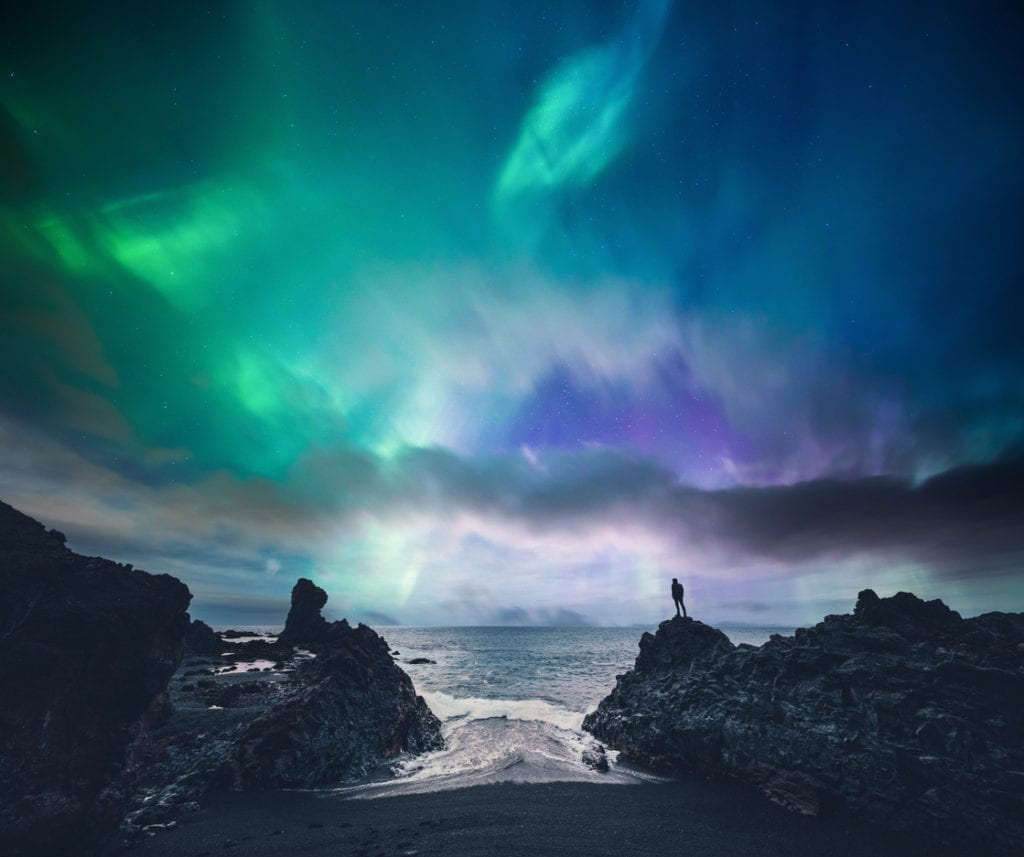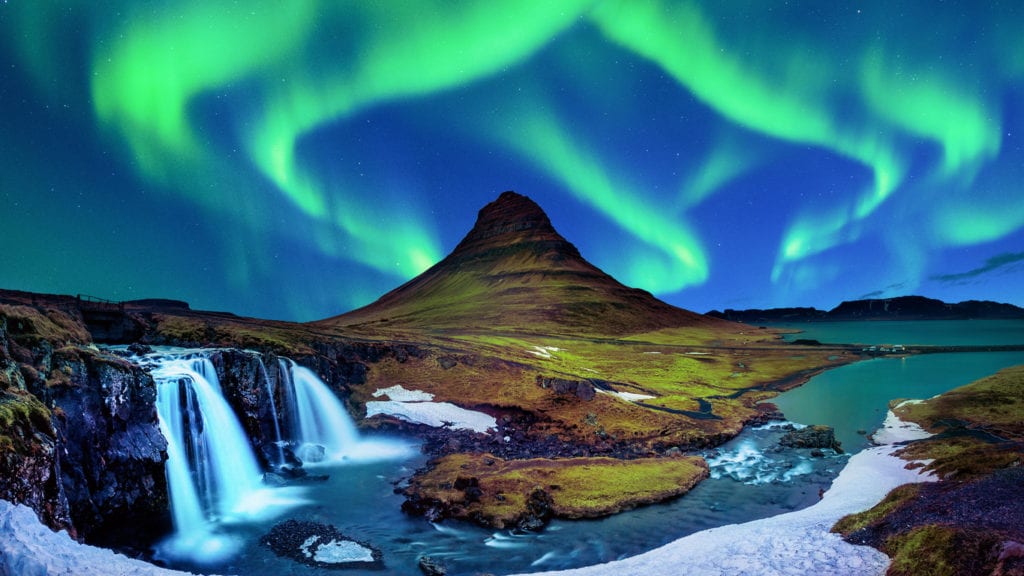Many Iceland visitors love to hunt the Northern Lights for their magical experience. Do you want to know the best time and place for an ideal Northern Lights tour? We’ve put together a guide that will help you discover this beautiful scenery when you next visit Iceland. Read on to know how you can make your way to the Northern Lights in Iceland.
Northern Lights Overview

First, let’s find out what are the Northern Lights.
Northern Lights (aurora borealis) are dancing lights with varying colors. While most of them appear as green, they could also be red, orange, pink, or purple. These lights appear when solar particles ionize as they enter the earth’s magnetic field. The ionized particles release energy, which appears as green streaks across the sky.
They have different intensities depending on the particles’ acceleration and the sun’s activity. While you’ll expect to find these auroras all year long, irregular solar activity obscures their appearance. More often than not, bright sunlight will deny you the view of the Northern Lights – more reason why you need to know optimal locations and times you would expect this magical experience.
You’ll only find auroras in the poles mainly as a result of the earth’s magnetic field. Ideal locations are situated above and below the 600 latitude mark in the north and south, respectively. The Northern and Southern hemispheres draw these particles towards them, thanks to their magnetic poles. Iceland matches these specifications as it located at the 640 latitude.
Back in the day, many theories were rife among different cultures. From stories of resurrected legends to glinting armors of past heroes, everyone had their side of the story. At some point, Native Americans believed that the lights indicated whether or not ancestors were pleased, depending on their brightness. Science has since cleared the air about the real reason behind this phenomenon.
Optimal Conditions for the Northern Lights Tour
While patience and luck may influence whether you’ll experience a successful hunt, try to schedule your tour around these conditions.
- An especially dark night.
- Little to no unnatural light.
- Little to no cloud cover.
- Enough solar activity.
- Plan between September to April.
Check out the cloud cover and aurora forecasts to make a solid decision on the best time to plan your hunt. On a scale of 0-9, anything below 2 means that you will miss out on the Northern Lights in Iceland. Reports from Icelandic Met Office should cover you on the forecasting front. For a clear sky, look out for the white patches. Dark green spots on the forecast represent a cloudy sky.
North Iceland
North Iceland and the Westfjords are ideal locations for auroras thanks to their long hours of darkness. Around the winter equinox, you might enjoy up to 22 hours of darkness in areas like Reykjavik. Compared to the south-east, North Iceland also provides brighter weather suitable for the perfect view.
November-February
Speaking of darkness, months between November and February are the darkest months in Iceland. These months provide the most extended window for viewing the Northern lights. You’ll, however, have to do with rough weather, lots of rain and snow, between January and February.
While you can view auroras over the capital or town, sites away from city lights improve your chances of seeing the remarkable lights. These locations will also offer an authentic and natural experience. In some cities, you can count on the special Northern Lights wake-up service when the lights appear.
April or September
If you’ve scheduled your trip around April or September, you may want to stay in a camp. Take advantage of the rural setting and get optimal conditions for the Northern Lights in Iceland.
Do you want to increase further your chances of seeing an active aurora? Plan for a more extended trip to Iceland. The auroras tend to appear in cycles of two to three nights before having less activity for up to five consecutive nights.
Temperature is not a defining factor – a warmer night should, however, provide a more luxurious experience. You don’t also need to be on a mountain unless this view gives you more darkness.
How Should You Hunt?
For a successful hunt, you could either opt for a guided tour, boat cruise, or a personal drive around Iceland. A guided tour is a safe bet given that you’ll be working with locals, obviously well-versed with the surroundings. The mobility from such visits ensures that you’ll get to optimal locations. The experts will also help you take the perfect shot of the auroras.
Budget
Depending on your budget, you could book the relatively cheap bus tours or opt for the fancier super-jeep tours. The latter option comes with the advantage of better access to highly remote locations. Bumpy trails and rivers won’t impede your excursion as you traverse the rural areas.
Boat
If you love vast waters, then hunting the aurora by boat should be incredible fun. You could catch your boat at either the Akuyerki or Reykjavik port. The out-to-sea environment free from any light pollution, provides an astonishing view of your exploits.
Faxafloi Bay and Eyjafjorou Fjord will also provide excellent viewing locations. While at sea, you may bump into whales, porpoises, and dolphins that will enhance your tour.
Car
Frequent Iceland visitors should consider taking a personal drive around the country for an adventurous experience. Renting a car comes with greater freedom – no time limits, no distractions, and no location restrictions.
A four-wheel-drive vehicle is your best bet for a personal drive. Before you hit the road, ensure that the weather and road conditions won’t impede your journey. Icy road conditions between November and March may cause you a little problem if you are not familiar with such terrains.
If you are working on a budget, try to catch the auroras within your host city. You’ll, however, need to find the darkest site in your location. The outskirts of Akureyri provides a high vantage point if you stay outside Reykjavik. Oskjuhlio forest also provides a serene dark environment for the perfect view.
Parks
You don’t fancy the forest environment, try the Laugardalur or Klambratun parks. The idea is to find a dark setting or a more secluded area with minimal light pollution. Areas with geothermal tubs should have a higher priority. Put on a warm jacket to brave the chilly winter breeze.
Countryside
Better still, you could take a chance with a visit to the countryside. Find an ideal Icelandic farm and camp there for a couple of days. Spend your days engaging with the culture and switch to Northern Light hunting at night.
Urban
The urban setting is excellent for your day tours but will let you down miserably when it comes to aurora hunting for two main reasons.
- Plenty of light pollution crowding out the colorful scenery.
- Little to no mobility meaning that when clouds block auroras, you won’t find an optimal viewing spot.
Package Northern Lights Holidays
In Iceland, you’ll find different self-drive and package holidays that will involve aurora-watching as part of the itinerary.
Take the seven-day Northern Lights package, for example. This self-drive vacation lets you admire incredible landscapes during the day and embark on your aurora hunt on nightfall. The Jokulsarlon glacier lagoon aurora watching experience takes your adventure to a whole new level.
The Snaefellness Peninsula experience, on the other hand, provides twelve solid nights for a fantastic experience. You can also opt for the seven-day winter package that offers incredible sights from a guided tour.
For a short trip, the South Coast four-day package and Ice caves three-day self-drive are fantastic options.
Photography

While viewing Northern Lights in Iceland is an incredible experience, you may want a couple of photographs to keep the memories alive. Carry a tripod stand along with a cable release to take stable photos – shaken pictures take away the beauty from the lights. Alternatively, you could leverage the camera’s self-timer for a more accurate photo.
Are you looking for great captures? Set your shutter speed between 15 and 30 seconds, aperture between f/2.8 and f/5.6, and ISO setting between 800 and 3200. Ensure that you have a couple of memory cards and spare batteries.
What Else Can You Do in Iceland?
Finding Northern Lights is an incredible experience, no doubt. The unpredictable nature of this activity, however, requires you to incorporate other activities into your itinerary. So what are the most popular activities in Iceland?
For one, you could visit Gullfoss Waterfall or the Pingvellir National Park. The Golden Circle and Geysir Geothermal Area are the other popular Iceland attractions. Alternatively, you could tour Iceland’s south coast. Besides the Dverghamrar Cliffs, you’ll enjoy the view of the Saljalandsfoss Waterfall.
Do you want a kick in your adrenaline? Snorkeling, whitewater rafting, and horse riding should work out just fine. Cave exploration tours and greenhouse visits should work well if you are trying to find a more leisured pace. With these activities, spotting the auroras will serve as an added advantage.
In Conclusion
The magical dancing of Northern Lights in Iceland is no doubt a sight to behold for both first time and regular visitors. Winter nights will, primarily, provide the best view. While this natural phenomenon is elusive and mostly unpredictable, the tips above should increase the chances of a successful hunt.
Are you in Iceland already? Rent a car with lagoon car rental in Iceland and drive to Northern Lights locations for a fantastic adventure.
Back